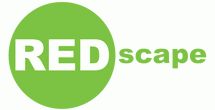REDscape is a design office for landscape and urbanism, operating in the disciplines of urban planning, regional design and landscape architecture. The physical surroundings that we live in can be seen as a highly dynamic playing field of often conflicting needs and claims, in which the forces of culture, social values and economics are in a constant process of reassessment and change. Within this field of tension is the requirement to interpret, conceptualise and organise new ideas, programmes and wishes into spatial solutions (in the form of maps, plans, models,) which offer new direction and meaning. REDscape is about fulfilling this requirement.
What does REDscape design?
REDscape operates at different scale levels, from micro; design for objects and private gardens to macro; designs for master plan, landscape plans and regional plans. All of these scale levels are seen as equally relevant in achieving a level of integrated high quality design. Design products are typically presented in the form of books, plans, models, and posters, which serve as the basis for implementing projects. Design for REDscape is about implementing as well as conceiving ideas.
What does REDscape represent?
REDscape represents functional and innovative designs, based on clear analyses, which serve the clients’ needs. REDscape represents respecting the values of existing physical environments (landscapes, city, people) while at the same time providing new directions for necessary change. REDscape represents using the qualities of the underlying landscape, whether of an urban setting or a region, as a focus for it’s design approach. REDscape represents design as an open process, which requires dialogue and exchange.
How does REDscape approach design tasks?
Landscapes are dynamic, cultural artefacts which have deliberately been shaped and crafted over long periods of time. Design tasks are approached by considering existing landscapes (regional or urban) as deliberately motivated systems that require further interpretation. REDscape views landscape as built artefact and not natural entity. This philosophy of landscape is described in the name of the office by integrating RED, the symbol of the built environment with – scape, the unbuilt environment to form an approach called REDscape. REDscape sets out to explore landscapes and urban conditions with a view to understanding and interpreting them culturally, emotionally and technically to then propose directions for change and transformation. Increasing urban expansion, higher living densities and changing global dynamics are all contributors to the increasing requirement for the careful understanding, utilisation, and interpretation of existing landscapes for the adaptation of new functions such as living, working, recreation, nature development, and water management.
